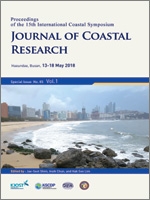Kim, M.; Lim, H.S.; Do, J.-D.; Kim, S.-S.; Lee, H.J., and Shim, J.-S., 2018. Variations of nearshore currents induced by seasonal waves in Haeundae. In: Shim, J.-S.; Chun, I., and Lim, H.S. (eds.), Proceedings from the International Coastal Symposium (ICS) 2018 (Busan, Republic of Korea). Journal of Coastal Research, Special Issue No. 85, pp. 1551–1555. Coconut Creek (Florida), ISSN 0749-0208.
Haeundae, located on the southeastern coast of the Korean Peninsula, is a famous sand beach with a 1.6 km long, 70 m wide coastline. It suffers from wave-induced beach erosion in both summer and winter. For beach restoration, the Korean government has conducted beach nourishment (620,000 m3), and installed submerged breakwaters at both ends of the beach. Despite these efforts, the beach is still vulnerable to erosion caused by high waves. To understand beach erosion processes and sediment transport mechanisms, the government initiated an R&D project for the development of coastal erosion control technology since 2013. As part of the project, we have measured over three years of AWAC measurements at a water depth of 22 m and 1.8 km from the beach. Intensive measurements of wave, current, sediment transport near the surf-zone in summer and winter have been made using AWAC, VECTOR, and ADV with OBS. Analyses of nearshore currents induced by seasonal waves in the surf-zone have shown that cross-shore currents in summer are mainly induced by strong waves from the SSW or S that propagate to the beach due to wave breaking and shoaling effects on the reef near the beach. However, longshore currents in winter are induced by high waves from the E or ESE that propagate to the shoreline by diffraction at the east coastline. Eroded sand in summer returns along the beach by cross-shore and weak longshore currents induced by waves from the SSW or S. However, suspended sand in winter is moved to the west by strong longshore currents induced by waves from the E or ESE. Due to its pocket beach shape, beach erosion and sediment transport are caused by variations of nearshore currents induced by seasonal waves.





